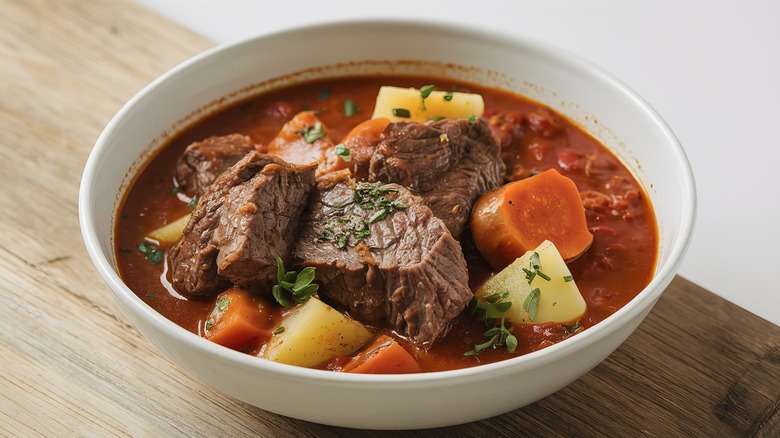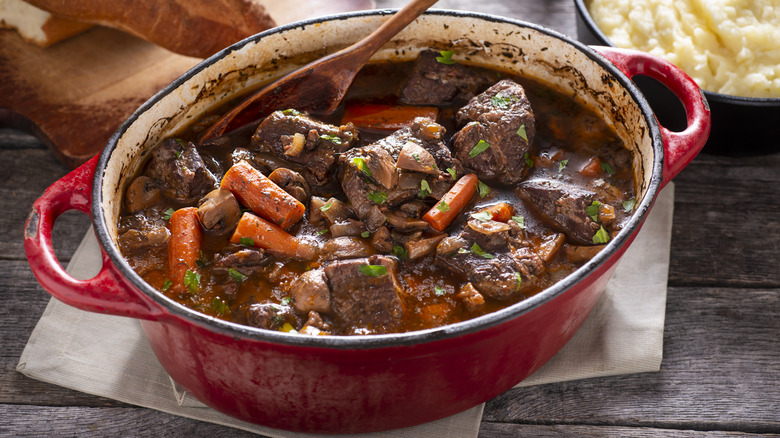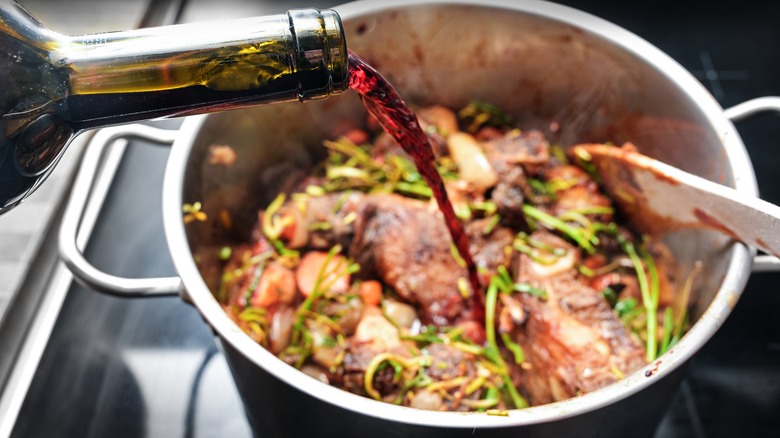Beef Bourguignon Vs Beef Stew: What's The Difference?
When the cold sets in, we often turn to comforting classics to warm our souls — and our stomachs. And very few things are more comforting than the simple combination of beef and vegetables, cooked gently for a very long time until tender and delicious. The humble beef stew is a classic of cookery found all over the world, from Taiwan, where it's made with doubanjiang (a spicy fermented bean paste), to Dublin, where it's transformed into a hearty beef and Guinness stew.
However, the two varieties we are perhaps most familiar with are a good, old-fashioned beef stew and the French classic beloved by Julia Child (and pretty much everyone else): boeuf bourguignon. You might assume that these are two sides of the same coin — that their only real difference is their names. But that's not quite true.
While they're close siblings, there are significant differences in their preparation and, importantly, their ingredients. The classic beef stew is a simple affair, flexible enough to allow for the use of pretty much whatever's on hand, but it's commonly made with a base of beef, potatoes, and a mirepoix of onion, carrot, and celery. It's a hearty dish — not particularly complex, but absolutely delicious.
Bourguignon, on the other hand, is more prescriptive: the beef and mirepoix remain, but with the essential addition of pearl onions, mushrooms, and lardons. Hard herbs like thyme and rosemary often join the party, along with parsley and (because it wouldn't be a French classic without it) garlic.
The cooking techniques set the two stews apart
The ingredients aren't the only things that set beef stew and boeuf bourguignon apart — the techniques involved in their preparation differ, too. Beef stew, for example, is the original one-pot wonder. Once all your mise en place is done, it's a simple matter of putting everything in the pan in the correct order — beef, vegetables, aromatics, stock. Set it to simmer, or place it in the oven on a relatively low heat, and three hours (or thereabouts) later, you've got yourself a stew. It's sometimes thickened with a cornstarch slurry or flour, but that's about as demanding as the technique gets. It's a wonderfully simple, efficient, and, importantly, accessible dish, requiring little in the way of arduous prep or hands-on cookery, while still yielding delicious results.
Bourguignon, by contrast, is a little more technically demanding. While there's nothing particularly difficult going on, the process is, much like the list of ingredients, significantly more prescriptive. There are more steps involved in the cooking process, and they must be followed in a specific order — rendering the lardons first, before browning the beef in their fat, for example — to achieve the depth and complexity a good bourguignon should have. Other ingredients are cooked separately and introduced later in the process to ensure they retain their optimum texture and flavor. The cooking time is longer, too, allowing the sauce to thicken on its own and tenderize the beef.
The cooking liquid is crucial in each stew's preparation
Sometimes, the liquid we use to make our stews goes unnoticed. It's the bass guitarist of this particular culinary band — rarely anyone's favorite player, sure, but the whole thing just wouldn't come together properly without it. Classic beef stew is usually topped off with stock — commonly beef broth, but sometimes chicken broth, vegetable stock, or even water. Occasionally, it's finished with a splash of red wine, or even beer, for added depth. The final flavor of the stew reflects this — it's meaty, deeply savory, and comes together with the other ingredients to produce a hearty final product.
Bourguignon, once again, is uncompromising. The cooking liquid here is primarily wine — a whole bottle, invariably red, preferably strong, and, if possible, from Burgundy. It's this that gives the dish its name, after all. This wine isn't the bass player — it's the frontman, the star of the show. It defines the dish, tenderizing the beef and infusing everything with a profound richness and a depth of flavor found in few other meals. Beef stock plays a crucial supporting role here, rounding out the boldness of the wine with saltiness and balance. While beef stew offers a somewhat straightforward flavor profile, bourguignon is marked by its sophistication — and much of that comes down to the wine, reducing as it cooks into a glorious, glossy sauce.



